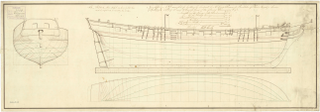HMS Rook was a Royal Navy Cuckoo-class schooner, that Thomas Sutton built at Ringmore (Teignmouth) and launched in 1806. In 1808 two French privateers captured and burnt her as she was on her way back to Britain from Port-Royal, Jamaica
HMS Barracouta was a Royal Navy Ballahoo-class schooner. The prime contractor for the vessel was Goodrich & Co., in Bermuda, and she was launched in 1804. Like many of her class and the related Cuckoo-class schooners, she succumbed to the perils of the sea relatively early in her career.
HMS Capelin was a Royal Navy Ballahoo-class schooner carrying four 12-pounder carronades and a crew of 20. The prime contractor for the vessel was Goodrich & Co., in Bermuda, and she was launched in 1804. Like many of her class and the related Cuckoo-class schooners, she succumbed to the perils of the sea relatively early in her career.
HMS Grouper was a Royal Navy Ballahoo-class schooner of four 12-pounder carronades and a crew of 20. The prime contractor for the vessel was Goodrich & Co., in Bermuda, and she was launched in 1804. Grouper was wrecked off Guadeloupe in 1811. This schooner was the only Royal Navy ship ever to use the name.
HMS Crane was a Royal Navy Cuckoo-class schooner of four 12-pounder carronades and a crew of 20. She was built by Custance & Stone at Great Yarmouth and launched in 1806. Like many of her class and the related Ballahoo-class schooners, she succumbed to the perils of the sea relatively early in her career.
HMS Pigeon was a Royal Navy Cuckoo-class schooner. Custance & Stone built and launched her at Great Yarmouth in 1806. Like many of her class and the related Ballahoo-class schooners, she succumbed to the perils of the sea relatively early in her career.
HMS Widgeon was a Royal Navy Cuckoo-class schooner built by William Wheaton at Brixham and launched in 1806. Like many of her class and the related Ballahoo-class schooners, she succumbed to the perils of the sea relatively early in her career.
HMS Sealark was a Royal Navy Cuckoo-class schooner of four 12-pounder carronades and a crew of 20. She was built by William Wheaton at Brixham and launched in 1806. Like many of her class and the related Ballahoo-class schooners, she succumbed to the perils of the sea relatively early in her career.

HMS Arab was the French 20-gun corvette Jean Bart, launched in 1793. The British captured her in 1795 and the Royal Navy took her into service. She was wrecked in 1796.
HMS Raposa was the Spanish brig Raposa, launched in 1804. She was captured A cutting out expedition in 1806 by boats from HMS Franchise in the western Caribbean captured her. The Royal Navy subsequently took her into service under her existing name. Raposa served in the Caribbean, repeatedly recapturing merchant ships that had fallen victim to French privateers. Thirteen months after being captured she ran aground while pursuing enemy ships. When they were unable to refloat Raposa, her crew set fire to her to avoid her capture, destroying her.
HMS Spitfire was the French 6-gun privateer schooner Poulette, launched in 1793, that the Royal Navy captured that same year. Lieutenant John Perkins commissioned her in April. Under Perkins she was part of Commodore John Ford's squadron at Jamaica. She was lost with all hands off Saint-Domingue, Hispaniola, in February 1794.

HMS Diligence was the name ship of her class of brig-sloops of the Royal Navy. She was launched in 1795 and lost in 1800. She spent her brief career on the Jamaica station where she captured four armed vessels, one of them after a short engagement, and many small Spanish and French merchant vessels in the Caribbean inter-island and coastal trade.
HMS Jamaica was a 10-gun two-masted Hind-class sloop of the Royal Navy, designed by Joseph Allin and built by him at Deptford Dockyard on the Thames River, England and launched on 17 July 1744. She and her sister Trial were the only sloops to be built in the Royal Dockyards between 1733 and 1748.

The French schooner Impériale was a 3-gun mercantile schooner-aviso of the French Navy commissioned at Guadeloupe on 23 September 1805. The Royal Navy captured her on 24 May 1806 and named her HMS Vigilant. The Navy renamed her HMS Subtle on 20 November 1806. She wrecked at Bermuda on 20 October 1807.

HMS Barbuda was commissioned into the Royal Navy in 1780 after having briefly served as an American privateer. Barbuda was one of the two sloops that captured Demerara and Essequibo in 1781, but the French Navy captured her there in 1782 and took her into service as Barboude. The French Navy sold her to private owners in 1786, and she served briefly as a privateer in early 1793 before the French Navy purchased her again and named her Légère. She served them until mid-1796 when the Royal Navy captured her and took her into service as HMS Legere. She was wrecked off the coast of Colombia, without loss of life, in February 1801.
Auspicious was launched at Newcastle in 1799 and was wrecked at Heneaga on 16 August 1801. She was part of a convoy sailing from Jamaica to England when strong, unsuspected currents drove her, five other merchantman, and one of their escorts, the frigate HMS Lowestoffe on to the shore.
HMS Morne Fortunee was originally the Bermudian schooner Glory, launched in 1801 but captured in 1803 as the French privateer Morne Fortunée. She was wrecked in 1804.
HMS Volador was an ex-Spanish prize that the Royal Navy acquired in 1807 in the West Indies. Commander Francis George Dickens commissioned her.

HMS Bonetta was the French privateer Huit Amis, launched at Bordeaux in 1798 that the British Royal Navy captured in May. In her brief naval career she captured a number of small prizes, one of them a 2-gun privateer. Bonetta was wrecked in 1801.
HMS Fly was launched in March 1804. She was wrecked in March 1805.




